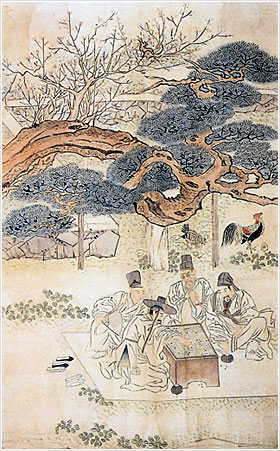The Early Stage (the Three Nation Period)

There have been six stages in the history of Korean Baduk: its introduction(Old Chosun until Unified Silla), its popularization period(Koryo until the mid-Chosun),the dominance of Sunjang Baduk(until the end of Chosun), the introduction of international rules(to 1945),the rising standard of Korean Baduk(1954-1989), the golden age(1989-present day).
The earliest Baduk story is told in Samguk-Sagi(History of the Three Nation)in the volume 'Paekche-bongi,Kae-ro-wang', which is the earliest history book, written retrospectively by Kim Bu-sik about the Three Nation period. This story is about a monk Do-rim from Koguryo.
"The expansionist King of Koguryo, Jang-su, sent his national Baduk master, the monk Do-rim, to the rival state Paekche to infiltrate the King's court, posing ad an exile. Kink Kae-ro of Paekche befriended Do-rim as a fellow player, and he persuaded Kae-ro to undertake extravagant public works such as new palaces. Once Paekche was depleted of its resources, Do-rim sent word to King Jang-su, who promptly invaded successfully in just seven days, with a minimum of conflict. King Kae-ro was killed and the Crown Prince escaped with his life to Ungjin to rebuild what was left of his country."
This took place in about AD 475, and is the most important international incident in which Baduk was intimately involved. Several stories involving Baduk are contained in the semi-historical book Samguk-yusa(Tale of the three Nations)demonstrating that Baduk was quite widespread and influential at national courts.
That Baduk was the preferred game in the three nations that cecame Korea, is also suggested by the 'Koguryo-jeon' chapters of Sindang-seo Xin Tang Shu(New Tang Histories), running to many volumes, and 'Paekche-jeon' chaprers of the Huju-seo[Hou Zhou Shu(History of the Later Zhou)
Popularization Stage (Koryo until mid-Chosun)
In Koryo before the Japanese invasion of 1592 (mid- Chosun era), Baduk came to be played throughout the upper classes. Thanks to many books we know that Baduk was played by the Kings Ye-jong and Kongmin- wang of Koryo; the Princes Yang-nyeong and An- pyeong of Chosun; the Senior Ministers Wu-tak, who was responsible for the celebrated mountain rock- hewn Baduk board, Lee Sek, who wrote the first Baduk literary note 'Gigi' , and Chung Mongju; the generals Kangjo, who played Baduk in camp, and Choi Chung- hun; the scholars Lee Gyubo and the Jukrim-chilhyun(seven wise men of Bamboo Wood, an intellectual retreat).
In particular, many scholars of the early Chosun period - Lee Gyubo, Seo Geojung, Sin Sukju, Lee Seok- hyung, Seong Hyun and other - regarded Baduk as a social refinement and wrote many Baduk poems, and literary notes.
The Golden Age of Sunjang Baduk (mid-Chosun until End of Chosun)

Through the end of 16th century, Baduk grew in popularity with both of the Yang-ban (equivalently ranked parallel civil and military upper classes).
It was one of the four gentlemanly arts (music, Baduk, painting and calligraphy) which they had to study.
The intelligentsia of the time have left us many writings about Baduk: General Lee Soon-sin' s Campaign Diaries, the female poet 'Hyuk-gi'(the first Baduk literary essay), Chung Won-yong 's ' Ki-seol ' (a baduk literary note), are prominent amongst numerous surviving documents demonstrating Baduk 's popularity at this time.
This is the period when Yu Seong-ryong is believed to have devised Sunjang Baduk. The Kuksu (national master) title was first recognized during this period, and the succession is still maintained to the present day.
Famous strong Baduk players included Lee Deok-won who played with Li Rusong, the general of the reinforcing Chinese army, Yun Hong-yim, Yu Chang-hong, the artist Choi Buk, Sin Gyeong, Whang-O and others.
Introduction of the International Rules of Baduk
Sunjang Baduk is quite different from Baduk as played internationally. The Japanese introduced the international rules of Baduk, as well as westernizing ideas, during their period of occupation from the late 19th century. Baduk ' s popularity spread through all social classes very quickly. Kim Man-su, Bek Nam-gyu and Noh Sa-cho were recognized as Kuksu, but in the Sunjang Baduk succession.
The Rules of Sunjang Baduk
The first 16 moves are prescribed and Black makes the first free play, leading straight into a fierce middle game. For this reason Sunjang Baduk, as a game, is considered both pragmatic and aggressive. Perhaps this is why the character of Korean Baduk player is the way it is. The other main difference is in the scoring. After all plays have been made, as many internal stones as possible are removed, leaving continuous boundaries. These need not be solidly connected, but no part of the boundary may be in dansu (atari). Then the totals of territory controlled are counted, with prisoners ignored.


